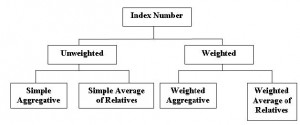- Index of Agricultural Production
There are 3 different kinds of index numbers of agricultural production namely, Ministry of Agriculture Series, Reserve Bank of India Index, & Food and Agricultural Organisation Index. The Ministry of Agriculture compiles the ‘Index Number of Agricultural Production’, the most commonly used index among these indices. At present the index number is constructed with triennium ending 1981-82 as base. The proportion of total value of production of each crop during the base year is the weight assigned to each crop.
- Uses of Index Numbers
Though originally designed to study the general level of prices or accordingly purchasing power of money, today index numbers are extensively used for a variety of purposes in Economics, Business Management etc. and for quantitative data relating to production, consumption, profits, and personnel phenomenon for two periods, places, etc. The main uses of index numbers can be summarised as follows:
- Index Numbers as Economic Barometers/Barometer of the Economy. In the words of G. Simpson and Kafka, “Index Numbers, are today one of the most widely used statistical devices… They are used to take the pulse of the economy and they have come to be used as indicators of inflationary or deflationary tendencies.”
- Index Numbers help in Studying Trends and Tendencies. Since the index numbers study the relative changes in the level of phenomenon at different period of time, they are especially useful for the study of general trend for a group phenomenon in a data of time series.
- Index Numbers help in Formulating Decision and Policies. Index numbers of the data related to prices, production, profits, imports and exports, personnel and financial matters are indispensable for any organisation in efficient planning and formulation of executive decisions.
- Consumer price indices are useful for:
- i. Measuring the purchasing power of money,
- ii. Deflation of income and
- iii. Wage negotiations and wage contracts.
- Limitations of Index Numbers
Although index numbers are the indispensable tools in economics, business management, etc., they do have their limitations and proper care should be taken in using and interpreting them, some of their limitations are enumerated below:
- Since index numbers are computed from sample data, all the errors inherent in any sampling procedure enter its construction. Hence, index numbers reflect only the approximate changes in the relative level of a phenomenon.
- At each stage of the construction of the index numbers, starting from selection of commodities to the choice of required formula, there are chances of the error being introduced.
- Due to rapid advancements in science and technology these days, there are rapid change in tastes, customs and fashions and consequently in the pattern of consumption of various commodities among the people in society. Hence index numbers, may not be able to keep pace with the changes in the nature and quality of the commodities consumed at the two periods being considered and hence may not be truly representative.
- By subjective selection of base year, commodities, price and quantity quotations, index numbers are liable to be manipulated by selfish persons to obtain the desired results.
In spite of the above limitations, the index numbers of properly constructed with caution are extremely useful devices.
Click here for government certification in Accounting, Banking & Finance





6 Comments. Leave new
Well written !
Good one !
well written!
The concept is good and idea and knowledge which you gave is quite emphasizing. Looking forward to have some articles on this.
Nice work..
informative.